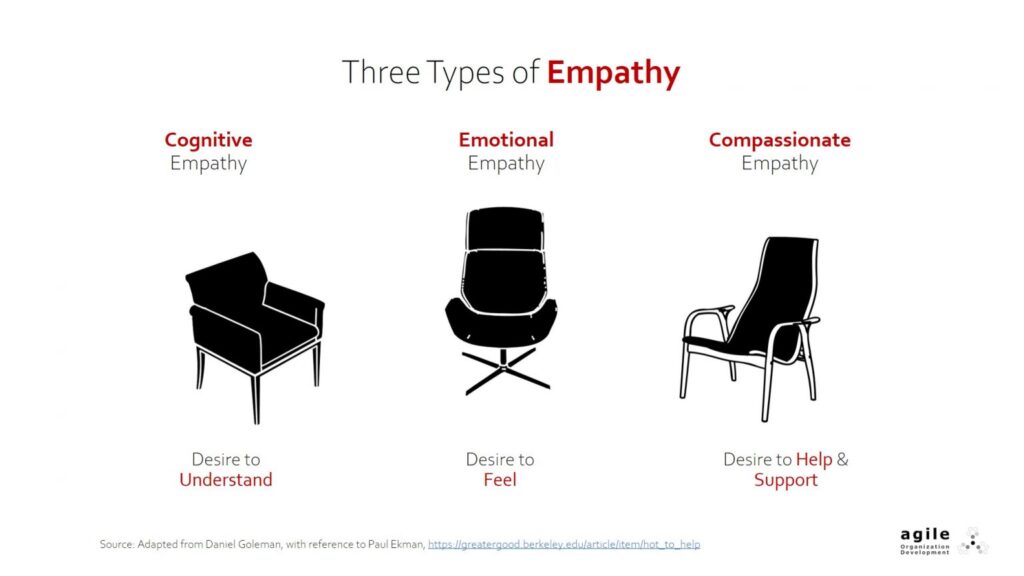“I try to remember that my team members are people. I always remember human first, employee second.” One of my amazing clients said these incredible words.
 Get this.
Get this.
60% of CEOs believe that their organizations are empathetic.
While just 24% of the employees in these organizations agree.
This is a giant disconnect resulting in 1 in 3 employees leaving their companies for a more compassionate environment.
Now, get this.
A Harvard Business Review survey reveals that 58 percent of people say that they trust strangers more than their own boss. Wow! We live in a world where cultural trust is at an all time low. Leaders who build trust with each of their team members will be in an incredible position to not only better themselves but also help their employees and foster a trust-filled environment.
The challenge? Empathy is learned on an individual level. It doesn’t come from an employee handbook, nor does it trickle down from management. Each of us has to want to be an empathetic leader. Once we want it, we can build the skills to own it.
The Challenge & Psychological Principle:
People tend to fall into two categories when it comes to empathy:
- People who are not empathetic enough and
- People who are too empathetic too much of the time.
The good news is that we all have three types of empathy to try on for size. According to psychologist Daniel Goleman, empathy is one of the five key components of emotional intelligence – a vital leadership skill. It develops through three stages: cognitive empathy, emotional empathy, and compassionate empathy.
A recent 2021 study in the Journal of Psychology and Aging studied how emotionally demanding occupations provide opportunities to practice empathy. They found that people learn about the double-edged nature of sharing other’s feelings as they progress in their career, and thus, keep a healthy balance – they get into the lives of their co-workers just enough but not too much.
A challenge is that not all empathy is created equal. One form of empathy is being able to see things through the eyes of someone else. Psychologists call this “perspective-taking” or “cognitive empathy.” In fact, according to social science researcher Brené Brown, perspective taking is the core of empathy. In other words, to be empathetic you must learn how to understand others from their perspective. Basically, it’s the old adage – “put yourself in their shoes!” The goal here is to seek an understanding from their perspective.
Emotional empathy or what psychologists call “emotional contagion,” is physically feeling how another person is feeling, as if the feeling has been spread from one person to the others. For example, when we start to cry when a dear friend is crying. Compassionate empathy goes beyond mere understanding and moves us to help others. Coaching is an example of compassionate empathy in action.
Each type of empathy has a time and place – great leaders know when to use each.
Mindset Shift:
- It’s important to remember the difference between sympathy and empathy, as the two are often confused. Sympathy is typically defined by feelings of pity for another person, without really understanding what it’s like to be in their situation. Empathy, on the other hand, refers to the capacity or ability to imagine oneself in the situation of another, experiencing the emotions, ideas, or opinions of that person. Empathy is a goal for emotional intelligence growth!
- Perspective-taking is listening to other people’s experience and acknowledging it is real to them. “What you see is as true, real and honest as what I see, so let me be quiet for a minute, listen and learn about what you see. Let me get curious about what you see. Let me ask questions about what you see.”
Performance Shift:
- Treat your team members like humans – not just employees. Real connections and friendships at work matter, and empathetic leadership is a tool that you can use to establish bonds with those you’re privileged to lead.
- Watch for signs of burnout in your team members. Managers who are skilled at empathetic leadership are able to recognize signs of overwork in others before burnout becomes an issue that results in disengagement or turnover. Take a few extra minutes each week to check in with team members and gauge how they’re handling their current workload and home life. These few moments are worth your time investment!
- Show sincere interest in the people who report to you. Part of leading with empathy involves working to understand the unique needs and goals of each team member and how to best match work assignments to contribute to both performance and employee satisfaction. Team members who see that their manager recognizes them in this way are more engaged and willing to go the extra mile. Ask them about the projects they are working on and how they want to personally grow in their career.
- Demonstrate a willingness to help an employee with personal problems. Lines between work and personal life are becoming increasingly blurred. Empathetic managers understand that their team members are dynamic individuals who are shouldering personal problems while having to maintain their professional responsibilities. Ask how things are going outside of work. Care.
- Keep the lines of communication open. In a world full of Zoom calls and texting, think outside the box and call your team members on the phone to check in. Take them out for coffee or lunch when possible. Don’t underestimate the investment of in-person conversations. So, this next week, who do you need to make a more empathetic connection with?
- Celebrate wins – at work and outside of work. Empathetic leaders celebrate both the personal and the professional wins of their team members. Know what is going on with your team and find ways to show you care. So, who on your team is feeling tremendous growth and success because they stepped outside of their comfort zone, tackled a challenge and catapulted their development or their career? You need to say something to this person.
- Give the gift of time. Great leaders give their team members the gift of time when they need it – extra time to finish a project, extra time to take care of themselves and their families. So, cancel that meeting this week that might be bogging your team down.
Seeing things from another person’s perspective enables people to deal with conflict not from a place of anger or a desire for retribution, but from an emotionally healthier place in which the other person’s emotional needs come first.
Fortunately, it’s not a fixed trait. Empathy can be learned. If given enough time and support, leaders can develop and enhance their empathy skills through coaching, training, or developmental opportunities and initiatives.
Our team of coaches show managers and leaders how to be more empathetic. If you want to learn more about how your work can add more value and explore better ways to be productive, reach out to Chris!
Co-authored by: Betsy Moore, Industrial/Organizational Psychology Consultant & Health Coach

Wieck, C., Kunzmann, U., & Scheibe, S. (2021). Empathy at work: The role of age and emotional job demands. Psychology and Aging, 36(1), 36–48. https://doi.org/10.1037/pag0000469
Businesssolver, The State of Workplace Empathy Study, 2021














0 Comments